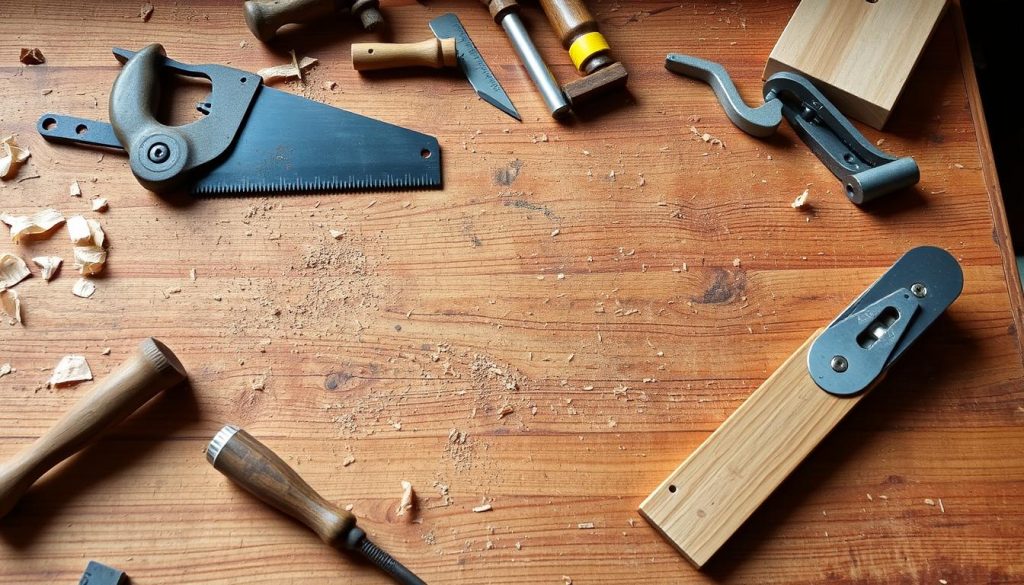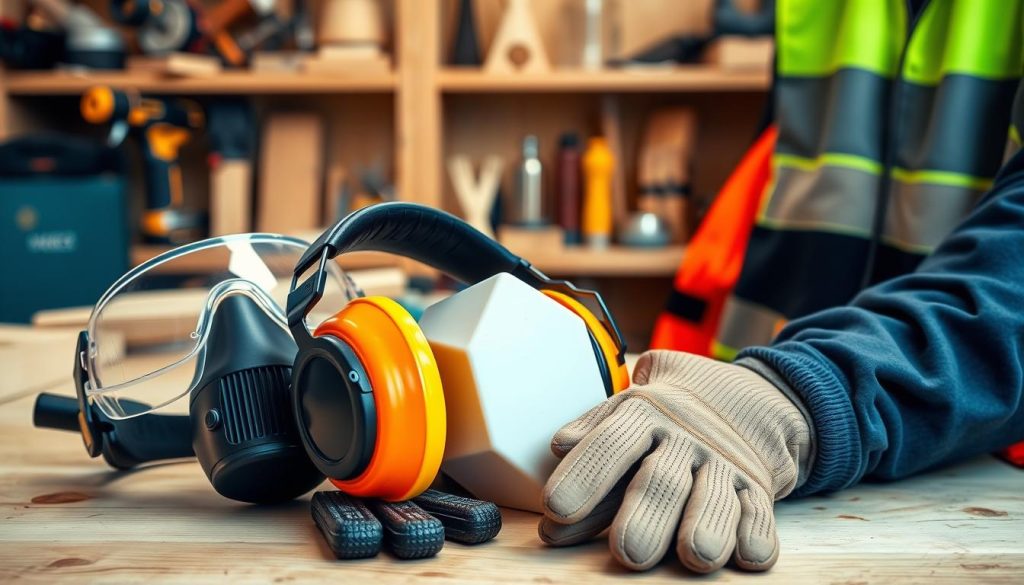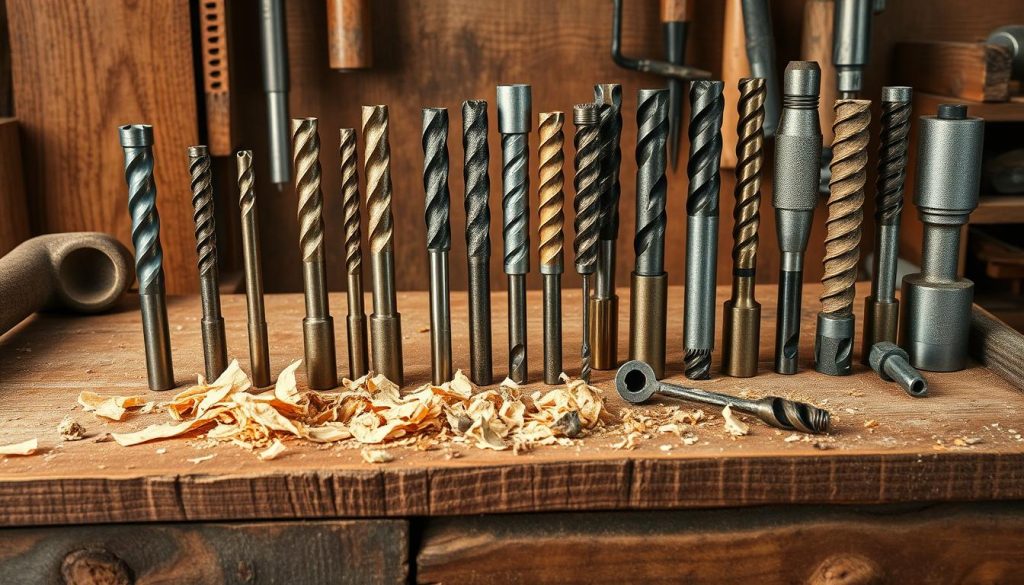Starting your woodworking journey as a DIY enthusiast means you need the right tools. A utility knife is great for scribing wood and cleaning joints. A layout square helps make square cuts.
High-quality chisels are key for precise joinery and shaping details. They should be made from durable materials like high-alloy carbon steel. A sturdy hammer and reliable tape measure are also must-haves.

Key Takeaways
- Essential woodworking tools include a utility knife, layout square, chisels, hammer, and tape measure.
- Chisels made of high-alloy carbon steel or chromium-vanadium alloyed steel provide precision and durability.
- These basic tools form the foundation for a wide range of DIY woodworking projects.
- Investing in high-quality tools can improve the accuracy and efficiency of your woodworking endeavors.
- Starting with a well-curated set of essential tools can help develop fundamental woodworking skills.
Understanding Basic Woodworking Setup
Creating a good woodworking setup is key for safety and efficiency. It involves choosing the right safety gear and organizing your tools. Each part of your workshop is important for your woodworking journey.
Workshop Safety Essentials
Safety is the top priority in woodworking. You need dust masks to protect your lungs and goggles for your eyes. Good ventilation and a clean dust collection system also keep your workspace healthy.
Space Requirements for Tools
Having enough space is vital for your workshop. You need room for tools and projects. A well-planned layout makes your work safer and more efficient.
Tool Storage Solutions
Good tool storage keeps your workshop organized. A tool cabinet or pegboard helps you find what you need quickly. It also protects your tools from damage.
By focusing on these basics, you can make a safe and efficient workspace. A solid setup is the foundation for great woodworking projects.
Getting Started with Hand Tools
Starting your woodworking journey as a DIY enthusiast? Learning about essential hand tools is key. These tools give you precision, control, and the joy of traditional craftsmanship.
A good starter kit should have a No. 5 Jack plane and extra irons. Also, include three chisels of different widths. Don’t forget measuring and marking tools like a combi square, a 6″ rule, and a marking knife.
For sawing, a Japanese back saw or a Veritas tenon saw is great for precise cuts. You’ll also need a panel saw, like the iconic orange-handled Irwin saw. A Thor mallet or similar is best for driving chisels. An eggbeater or small cordless drill is perfect for drilling.
Sharpening tools, like a double-sided Norton oil stone, are crucial for sharp edges. You might also want a flat screwdriver, a claw hammer, a bevel, a router plane, and a coping saw.
As you get better, a sturdy workbench is essential. It should have a 3″ solid top and a strong vise. With these tools, you’ll be ready to make amazing woodworking projects.
Must-Have Measuring and Marking Tools
In woodworking, getting measurements right is crucial. The right tools, like layout squares and marking gauges, are key. They help you achieve professional results. Here are the essential tools every DIYer should have.
Layout Squares and Rulers
Layout squares, like the 12-inch combination square, are great for square cuts. They also check surface flatness and angles. A good ruler is also vital for precise measurements and lines. Choose one with clear markings and durable build.
Marking Gauges and Pencils
Marking gauges help draw parallel lines accurately. Sharp pencils or woodworking measuring tools make measurements clear. A scratch awl marks starting points for cuts or joints, ensuring alignment.
Measuring Tapes and Calipers
For long measurements and detailed checks, a measuring tape and marking tools for woodworking calipers are essential. A tape measure with both metric and imperial markings is handy. Digital or vernier calipers give precise readings, crucial for accurate work.
Learning to use these tools well will help you succeed in woodworking. With the right tools and skills, your DIY projects will show off your woodworking talent.
Essential Cutting Tools
Cutting tools are key in woodworking. They range from basic handsaws to advanced power saws. These tools help you shape and size your wood pieces accurately.
Handsaws are the foundation of woodworking. They come in many styles for different tasks. A good handsaw is essential for clean cuts or detailed curves.
Bandsaws offer a mechanized way to cut. They’re great for curved or irregular cuts. This makes them perfect for complex furniture projects.
Jigsaws are also versatile. They’re good for straight lines, curves, and even square circles in thinner materials. However, they’re not best for thick boards.
Choosing the right cutting tool depends on your project and personal preference. Consider the blade type, power source, and project needs. Knowing each tool’s strengths and weaknesses helps you make the best choice.
Woodworking Tools for Beginners
If you’re new to woodworking, starting with the basics is key. You’ll need a toolkit that covers the essential tools for your projects. Whether you’re doing simple DIY tasks or more complex woodworking, the right tools make a big difference.
Basic Tool Kit Components
A good starter kit for beginners should have these tools:
- Utility Knife: Great for cutting, scoring, and trimming wood.
- Layout Square: Essential for accurate marking and measuring.
- Chisels: A set of sharp chisels in different sizes for shaping and finishing.
Budget-Friendly Options
Looking for affordable tools? There are many options. For example, a Combination Square from Amazon costs about $109.22. You can also find a Block Plane at Walmart and a Chisel Set at Lowe’s for $39.98. These tools offer great value without sacrificing quality.
Tool Quality Considerations
Quality is important, even if it means spending a bit more. Tools like a Jigsaw from Amazon for $89 or a Sharpening System can cost more but are worth it. Look for well-known brands and read reviews to find the best value.
As you get better, you can add more tools to your collection. Power tools like a Drill/Driver Combo, a Palm Router, and a Random Orbit Sander will improve your work. These tools make your DIY projects better and faster.
Power Tools vs Hand Tools
Woodworking needs a mix of power and precision. Power tools like cordless drills and sanders make big projects easier. Hand tools, however, give more control and are perfect for detailed work.
Choosing between power tools and hand tools depends on the project. Power tools are fast and consistent, great for making many parts the same. They’re better at cutting curves and boring holes than hand tools.
- Power tools are up to twice as efficient as hand tools in woodworking.
- They have a higher accuracy rate than hand tools.
- Power tools make woodworking tasks faster, saving a lot of time.
But hand tools are better for fine tasks like trimming and shaping. They’re also cheaper and safer to use with the right handling. Power tools need safety equipment and knowledge to use safely.
Using a mix of power tools and hand tools is often the best strategy. Knowing when to use each helps woodworkers get the job done well and safely.
Choosing the Right Chisels and Planes
Woodworking chisels and planes are key tools for DIY fans. Chisels include bench, mortise, and paring types. They help clean out joints and saw cuts. High-quality chisels are made from durable materials like carbon steel or chromium-vanadium alloyed steel.
Types of Chisels
There are several types of woodworking chisels:
- Bench Chisels: These versatile chisels are great for many tasks.
- Mortise Chisels: Perfect for cutting square holes, they’re vital for joinery.
- Paring Chisels: With their long, thin blades, they’re best for fine finishing and shaping.
Essential Planes for Woodworking
Planes are vital for making smooth surfaces in woodworking. The basic hand plane is used for leveling and smoothing. For beginners, a Jack plane (Stanley #5) is a good choice. It’s versatile and can handle many tasks.
Power tools like surface planers also help with leveling and smoothing, especially for big projects. Getting a well-tuned hand plane or a top-notch power tool can greatly improve your woodworking.
Sanders and Surface Preparation Tools
Sanders and surface preparation tools are key for a smooth finish on woodworking projects. The random orbit sander is a favorite because it sands surfaces efficiently with rotating vibrations. It’s powerful yet easy to use, appealing to both DIY fans and pros.
But, sanders can kick up a lot of dust. So, wearing a dust mask is a must for safety. For hard-to-reach spots like corners, rasps are perfect. They’re great for filing, shaping, and fixing uneven surfaces.
There are many other tools for surface prep too. Hand planes, scrapers, and special sanding discs can all help get your project looking its best. The right tools can really elevate your woodworking.
Choosing the right sanders and tools depends on your project size, complexity, and your skill level. Whether you’re new to woodworking or have years of experience, the right tools can greatly improve your work’s quality and your satisfaction.
Workshop Safety Equipment
Woodworking can be a rewarding hobby, but safety is key. The right equipment is vital to prevent injuries and make your hobby enjoyable.
Protective Gear Essentials
Eye protection is a must in any woodworking workshop. Safety glasses or goggles protect your eyes from flying wood chips and sawdust. This can cause serious damage.
Ear protection is also crucial. Power tools and machinery can be very loud. Prolonged exposure can lead to hearing loss.
Respiratory protection is another important aspect. Dust masks or respirators with the right filters protect your lungs from harmful wood particles and VOCs in finishes. Choose a mask that filters out at least 95% of particles as small as 0.3 microns.
Dust Collection Systems
Keeping your workspace clean and well-ventilated is essential. A quality dust collection system can greatly reduce airborne wood dust. This makes your workshop safer and improves air quality.
With the right woodworking safety equipment and dust collection, you can enjoy your hobby more. You’ll have peace of mind and lower risks of injury or respiratory problems.

Understanding Power Saws
Power saws are key for woodworking fans. They make straight cuts and curves with ease. Let’s look at the types and what they can do.
Circular saws are popular for DIY projects. They come in various sizes and are easy to carry. They’re great for straight cuts and can even cut at angles. Prices range from $40 to $100.
Miter saws are perfect for precise angled cuts. They’re great for trim, molding, and framing. Prices vary from $200 to $600 or more, based on features.
For big projects, a table saw is essential. They offer unmatched precision and can make accurate cuts. Prices are from $300 to $1,200, with cabinet models for bigger projects and portable ones for smaller spaces.
Linear saws, like jigsaws and reciprocating saws, have special uses. Jigsaws are good for curves and patterns, costing $30 to $200. Reciprocating saws, or “sawzalls,” are great for demolition and complex designs, priced $70 to $130.
Bandsaws are loved for cutting curves and angles. Prices vary from $100 for a benchtop model to $5,000 or more for industrial ones.
Whether you’re experienced or new to woodworking, knowing what each power saw can do is crucial. It helps you pick the right tool for your project and get the best results.
Clamps and Vises for Woodworking
Woodworking fans know clamps and vises are key for holding workpieces. They keep your materials steady for precise cuts and finishing. Let’s look at the types of clamps and vises and how to pick the best for your workshop.
Types of Woodworking Clamps
Woodworking clamps vary, each for different tasks. Here are some common ones:
- Bar Clamps: Great for big workpieces or joining pieces together.
- C-Clamps: Strong and small, perfect for gluing or drilling.
- Spring Clamps: Light and simple, good for quick holds.
Choosing the Right Vise
Woodworking vises hold your work steady for sawing, planing, or chiseling. Think about your projects and material sizes when picking a vise. Here are some options:
- Portable Woodworking Vise: Good for small projects or tight spaces.
- Heavy-Duty Woodworking Vise: Strong for big tasks and pieces.
- Quick-Release Woodworking Vise: Fast and easy for quick work.
Good clamps and vises improve your project’s accuracy and speed. Knowing the types and their uses helps you pick the best tools for your DIY woodworking.
Drilling and Boring Tools
As a DIY woodworking enthusiast, having the right tools is key. Drilling and boring tools are vital for precise holes and cavities in wood. They’re essential for many projects. Let’s look at the tools that can improve your woodworking skills.
The cordless drill is a must-have. It has adjustable speed and direction for various materials. Perfect for drilling holes and driving screws, it’s a favorite among DIYers.
For precise boring, tools like drill presses are great. They’re perfect for joinery and pilot holes. Drill presses have adjustable speeds and depth, making them a valuable addition to your workshop.
- Twist drills range from 1⁄64 ” to 11⁄2 ” and wire-gauge sizes from 1 to 80. They have specific RPM ranges for hardwood.
- Titanium-coated bits are better for cutting and last longer when drilling metal.
- Brad-point bits need specific RPMs for precise drilling, based on their sizes.
- Spade bits are for general drilling, from 1⁄4 ” to 11⁄2 “. They work well in hardwood at recommended speeds.
Having the right drilling and boring tools is crucial for any woodworking project. Knowing their capabilities can open up new possibilities. It can take your DIY woodworking skills to new levels.

Wood Finishing Tools and Equipment
Getting a professional finish on your woodwork is key. It makes your projects look better and protects the wood. You’ll need various tools for surface prep and applying finishes.
Surface Preparation Tools
Good surface prep is the base for a great finish. Sanders, like orbital and belt sanders, help smooth out surfaces. They remove scratches and ensure even textures.
Scraping tools, like cabinet scrapers and card scrapers, are also important. They get rid of tough imperfections, making the wood ready for finishing.
Finishing Application Tools
Applying finishes like stains, varnishes, or paints needs special tools. Brushes, rollers, and spray guns are used for different finishes. Brushes give you control and precision.
Rollers are great for big areas. Spray guns work well on complex projects for a smooth finish.